Evidence continues to mount that the US equity market is nearing a critical turning point — one that could evolve into something far more significant than a routine correction. Even as some investors remain cautious, overall investor positioning has reached levels of exuberance that show a near-total disregard for risk, the classic hallmark of speculative complacency.
In terms of enterprise value relative to GDP, the top 10 US mega-cap stocks are now valued 270% higher than the 10 largest market cap tech and telecom stocks were at the peak of the 2000 bubble. See the chart below. Similarly, the Warren Buffett indicator, which uses the total US equity market cap to GDP, is at levels far exceeding the dot-com era.
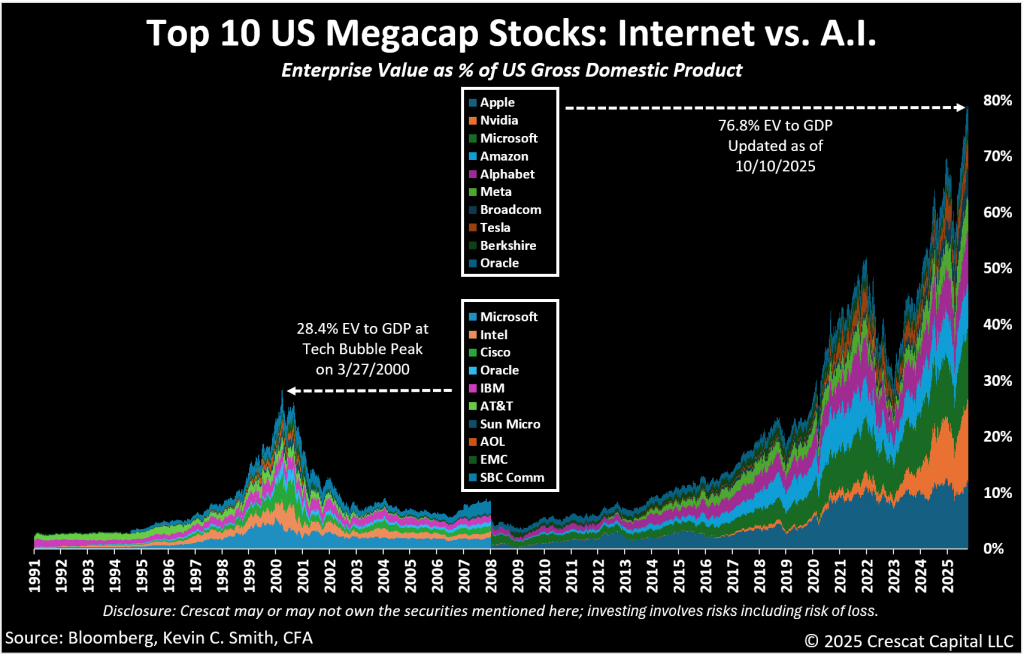 Credit markets tell the same story: high-yield spreads have compressed to below 3%, suggesting investors have largely stopped worrying about credit risk altogether.
Credit markets tell the same story: high-yield spreads have compressed to below 3%, suggesting investors have largely stopped worrying about credit risk altogether.
No matter how one looks at it, equity valuations have drifted back into rarefied territory. Robert Shiller’s cyclically adjusted P/E now stands above its 2021 peak, not far from where it sat at the height of the dot-com bubble. Together, these indicators paint a picture of a market increasingly detached from fundamentals and driven by momentum and belief. It feels like one of those moments when fear is scarce and greed has taken over. From both a tactical and historical perspective, this setup looks like one of the most precarious in recent memory.
The Dow Jones Transportation Index, often a reliable leading signal for broader equity trends, reinforces this view. As a real-economy barometer of logistics and industrial activity, it typically turns before the S&P 500 does. Today, however, the transports have failed to confirm the S&P’s push to new highs — a divergence that echoes the pattern seen just before the last major market correction.
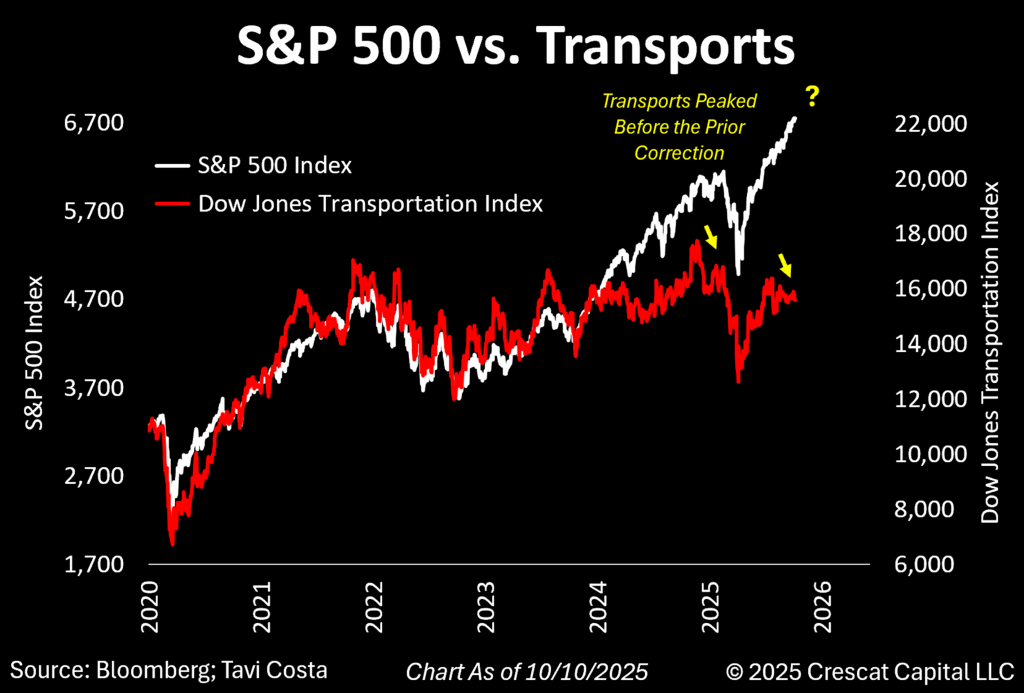 When the Music Slows
When the Music Slows
When forming a near-term tactical view, it helps to look beyond headline indices and focus on market breadth. Beneath the surface, weakness is spreading. Only about half of the S&P 500’s constituents now trade above their 50-day moving average — a sharp deterioration that reveals how narrow the rally has become. A handful of mega-caps are holding the index aloft while the broader market quietly softens. Historically, that kind of divergence rarely ends well.
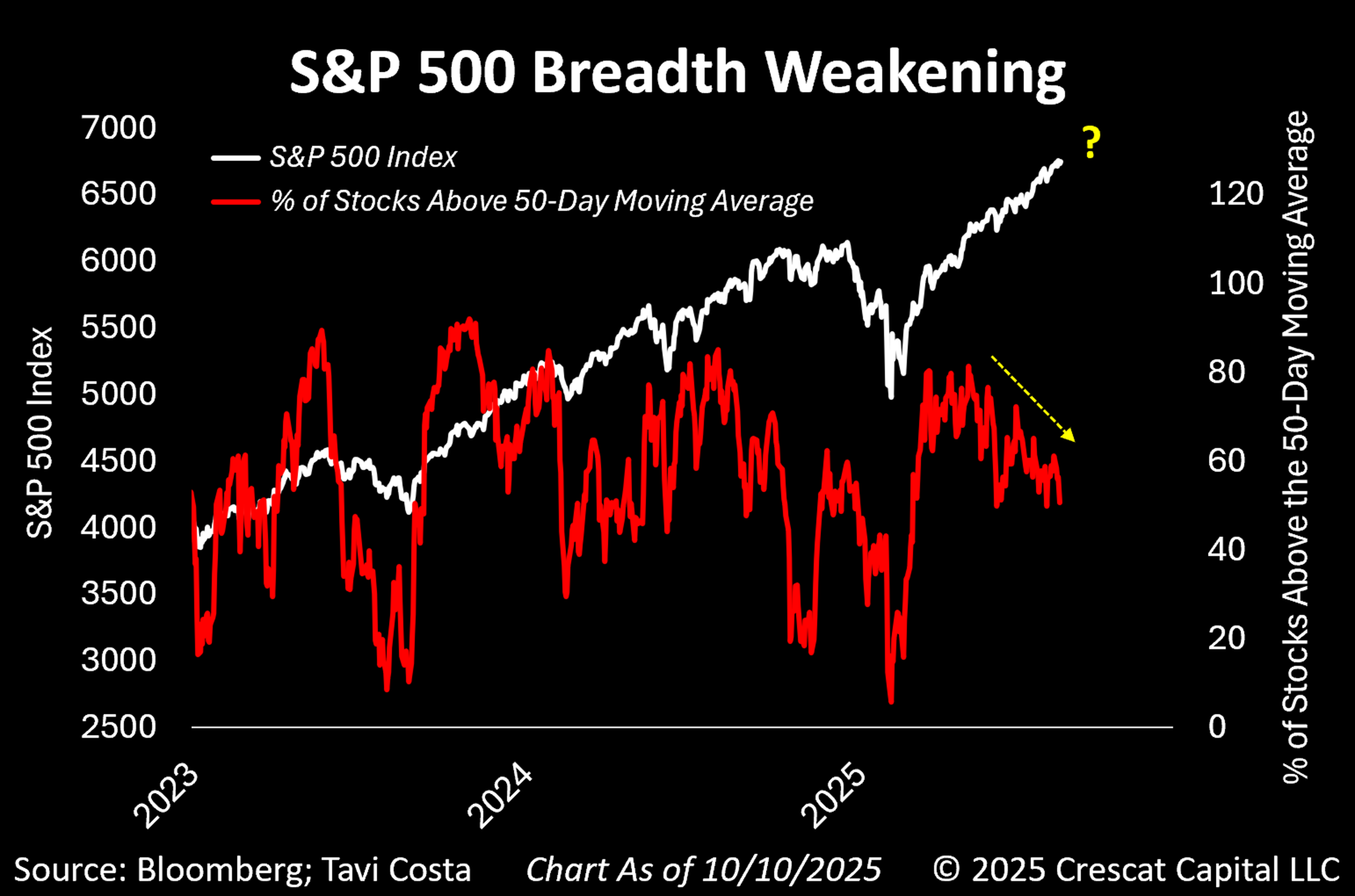 When the Consumer Falters, the Market Listens
When the Consumer Falters, the Market Listens
A similar story is unfolding inside the S&P 500 Consumer-Discretionary Sector, one of the economy’s most cyclical components. Barely 28% of those stocks sit above their 50-day moving average. That’s troubling. Consumer spending drives the bulk of US growth, and weakness here often signals broader economic fatigue ahead. Historically when this sector rolled over first, a wider market slowdown often soon followed.
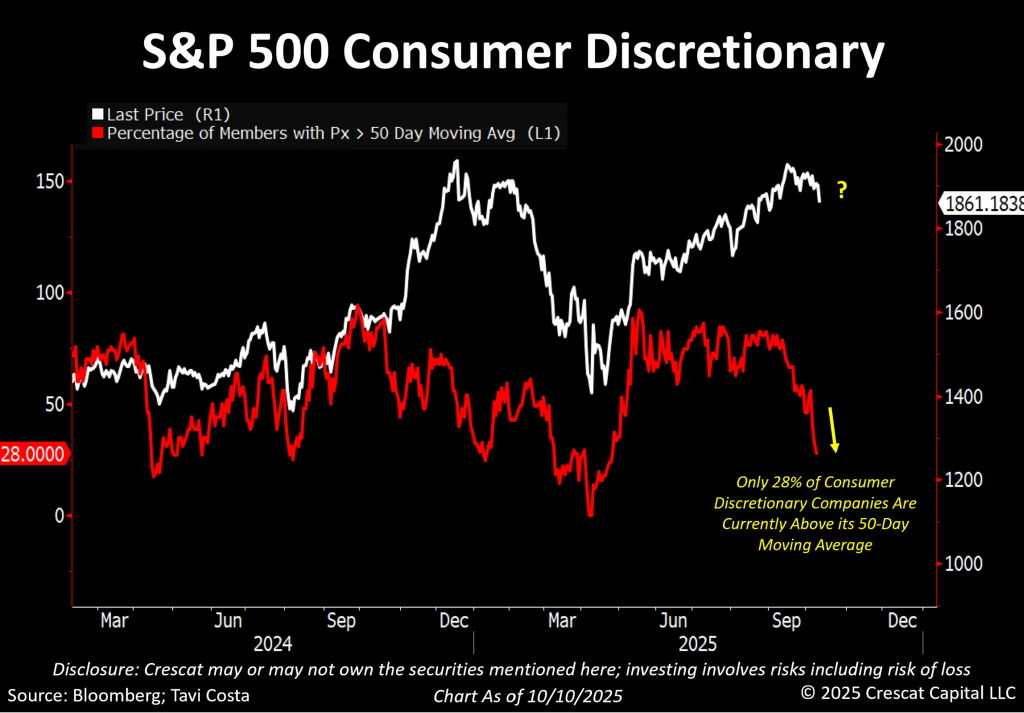 Revisiting the Limits of Market Rationality
Revisiting the Limits of Market Rationality
Valuation excesses always look obvious in hindsight. Yet here we are again, hearing that the difference between this market and the tech bubble is that “today’s big A.I. companies actually make money compared to the dotcoms.” But the top-10 mega-cap tech stocks in the 2000 Internet bubble, shown above, were also highly profitable companies at the peak of that macro cycle. So, that argument misses the point entirely. It’s not that the big tech firms are profitable that matters — it’s how much investors are willing to pay for that profitability and whether or not the growth and profitability are sustainable.
By almost any measure, investors are once again paying far too much for perceived growth. Even a basic price-to-earnings ratio shows the market trading close to the same extremes reached in 1999.
Yes, the P/E at the 2021 peak was marginally higher, but we believe the current environment feels eerily familiar — the same optimism, just wrapped in a different narrative.
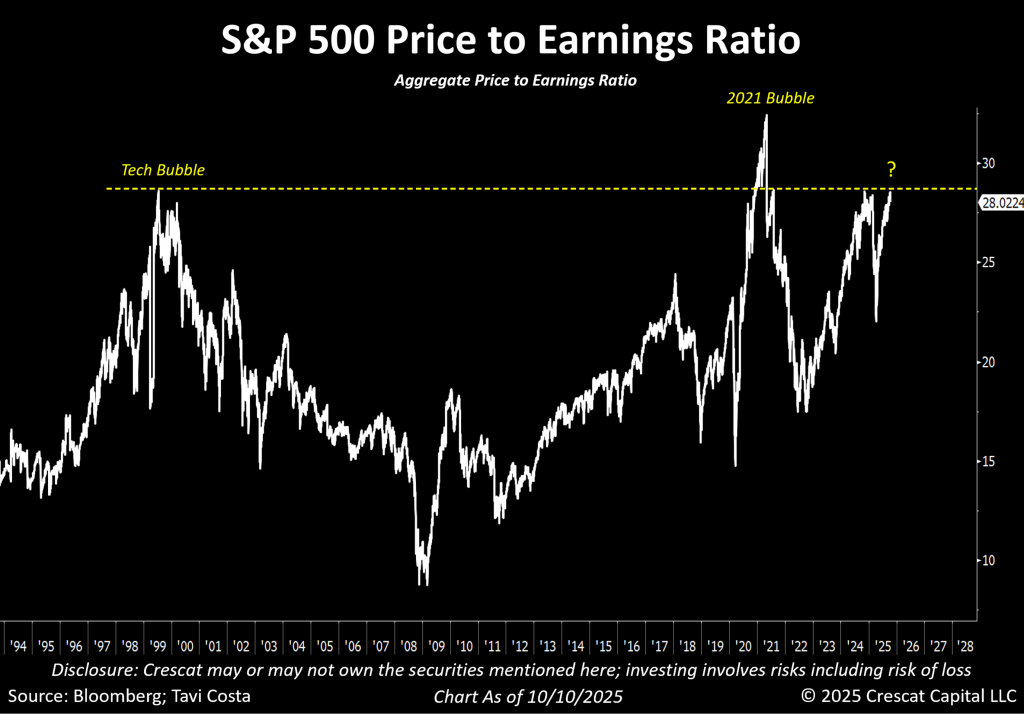
Gold Miners: Better Valuations and Better Growth Rates than A.I.
The logic that valuations aren’t dangerous until they match prior records shows how far the market appears to have drifted from any sense of balance. Deploying capital into the S&P 500 or Nasdaq 100 index Funds, dominated by the Magnificent 9 tech stocks, at these levels assumes that gravity no longer applies. We prefer to stay anchored in history. Rather than chase this illusion, we prefer to play what we believe is an impending Great Rotation out of mega-cap tech and into countercyclical value and growth stocks, such as the gold mining stocks, which have both lower valuations and higher current growth rates than big tech stocks, as we show in the chart below.
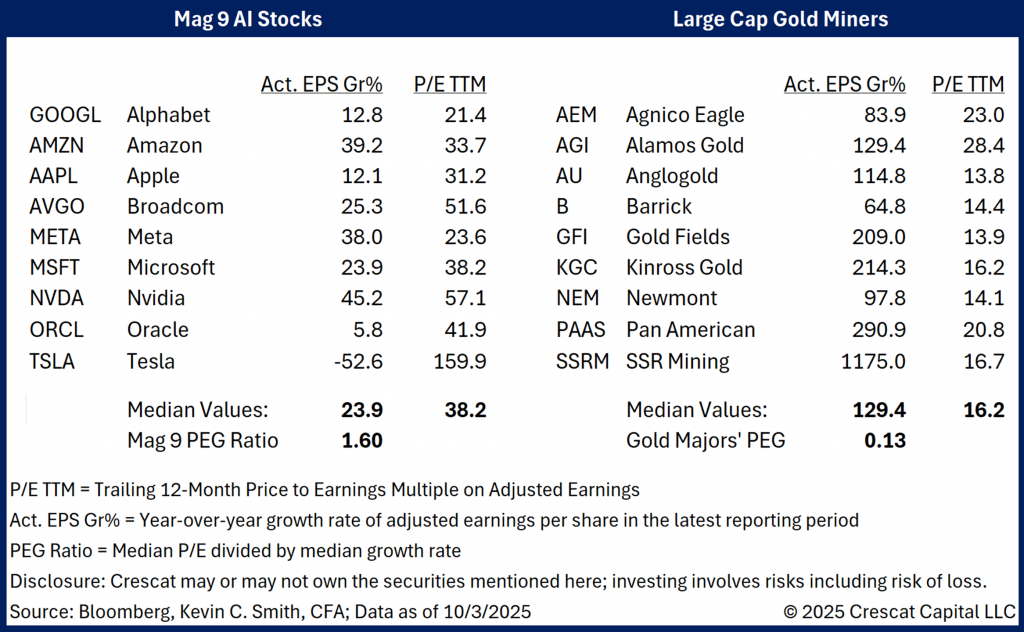 Looking at this data, it’s no surprise that the large cap gold miners are substantially outperforming the Mag 9 AI stocks already this year. These are some of the strongest scoring stocks in our multi-factor large and mid-cap equity quant model today, and we have owned most of them for several years now in our Large Cap SMA strategy.
Looking at this data, it’s no surprise that the large cap gold miners are substantially outperforming the Mag 9 AI stocks already this year. These are some of the strongest scoring stocks in our multi-factor large and mid-cap equity quant model today, and we have owned most of them for several years now in our Large Cap SMA strategy.
If one likes these major gold producers, we are confident they will love small cap explorers and developers, which we favor in our hedge funds. There, future growth and valuations are even more compelling in Crescat’s analysis. We invite you to inquire about our activist metals’ portfolio, which is the largest long-oriented theme across all our funds today.
In our macro and long/short equity funds, we are positioned for both sides of the likely shift. That is where we have been using what we see as inexpensive put options in the spirit of Nassim Taleb’s asymmetric hedging approach, giving us efficient downside exposure while helping to protect our long book. Of course, this approach will not appeal to all investors, particularly those more comfortable riding out what might be left of the momentum.
The Canary in Crypto’s Coal Mine
The cryptocurrency market has been a leading signal for speculative sentiment, in our view. In a recent CNBC interview, Jim Chanos illustrated this dynamic perfectly through his latest spread trade — shorting Michael Saylor’s Strategy Inc. while staying long Bitcoin. Strategy Inc., which effectively serves as a leveraged proxy for Bitcoin exposure, has often traded at a premium to its underlying digital assets.
Chanos pointed out that this “Saylor premium,” or the outperformance of Strategy’s shares versus Bitcoin itself, has shown a remarkably high correlation with the S&P 500 — a reflection of how tightly speculative behavior has become intertwined across markets. That premium now appears to be eroding. To us, that divergence signals something important: the highest-beta corners of the market are beginning to quietly de-risk ahead of a broader equity unwind.
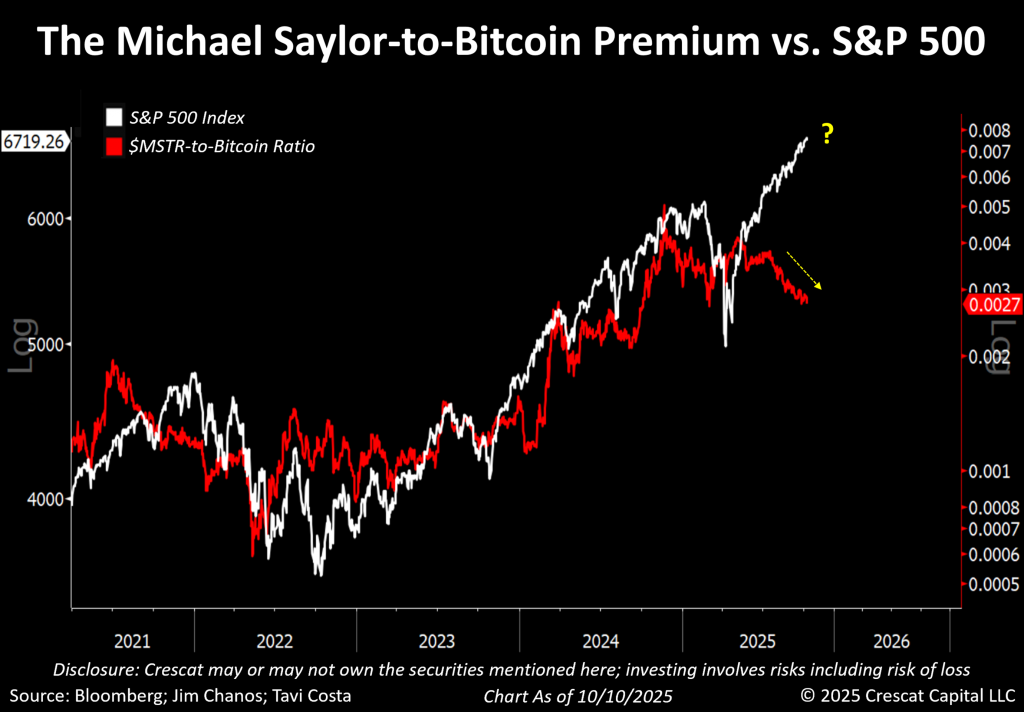 Monetary Overhang: Inflation’s Second Act
Monetary Overhang: Inflation’s Second Act
Signs of stagflation are creeping back into the data. Commodities are up double digits over the past year, while inflation in services — the stickiest component — continues to firm. Some attribute this to tariffs or politics, but the deeper cause is far simpler: excessive liquidity and a growing policy comfort with higher inflation as a tool to erode debt.
The latest ISM Services report tells the story clearly. The “prices paid” component is approaching 70, while employment has fallen well below 50. That combination — surging input costs with weakening labor demand — highlights the Fed’s policy trap in its purest form.
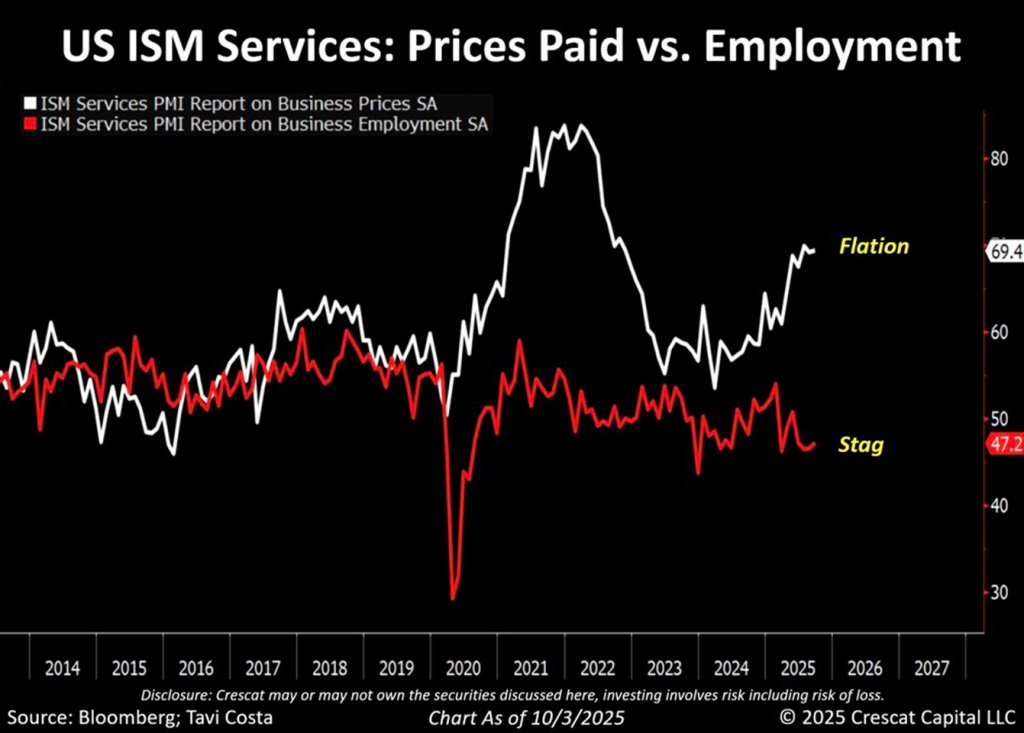 Inflation Risk Mispriced in the Age of Repression
Inflation Risk Mispriced in the Age of Repression
The divergence between commodity prices and market-based inflation expectations has reached extreme levels. In our opinion, commodities are the real anchor of inflation — the cost base of everything — and right now they’re sending a much louder signal than the bond market. The market’s complacency toward inflation risk is astonishing.
Meanwhile, both the Fed and the administration appear comfortable with financial repression as a policy tool. This approach may ease the government’s debt burden, but it also ensures that inflation pressures will continue to build beneath the surface. The more they lean on this strategy, the more fragile the system becomes.
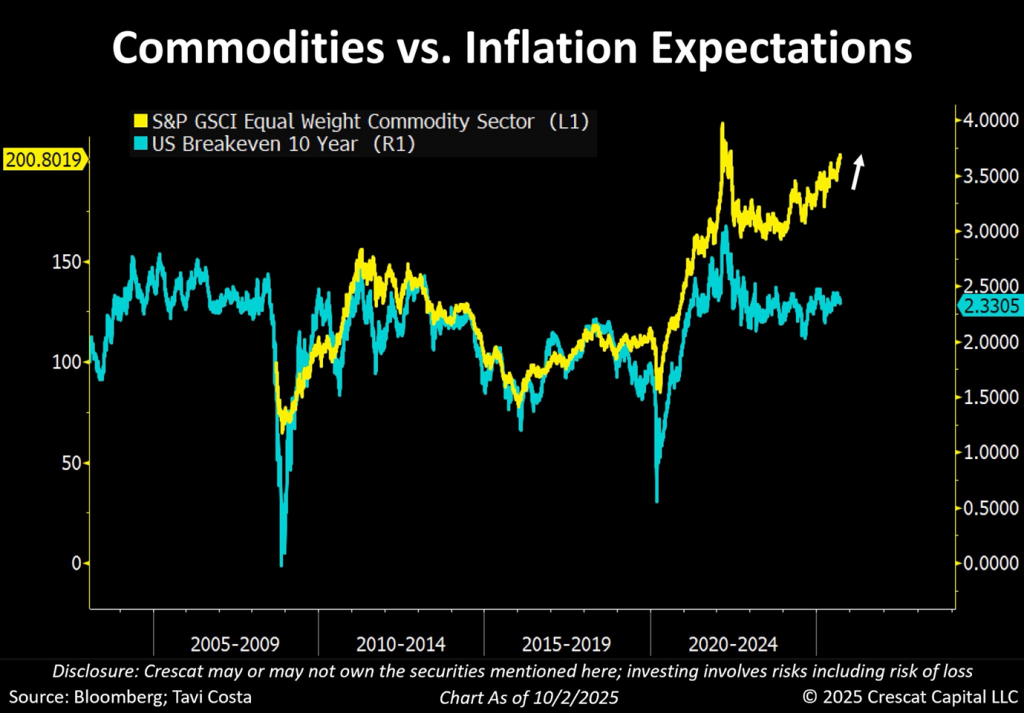 The Stag Half of Stagflation Takes Shape
The Stag Half of Stagflation Takes Shape
On the other hand, labor market conditions and business activity are now showing clearer signs of deterioration. While one might initially attribute this to data distortions, political factors, or frequent revisions to prior reports, the evidence of weakening fundamentals has become increasingly difficult to dismiss.
ADP employment data have consistently undershot expectations, job openings have declined materially, and ISM employment indices point to a meaningful slowdown in hiring momentum. This represents the “stag” component of the emerging stagflationary dynamic — an early indication of an economy losing traction. Historically, such trends tend to reinforce themselves, with weakening labor demand feeding broader economic deceleration.
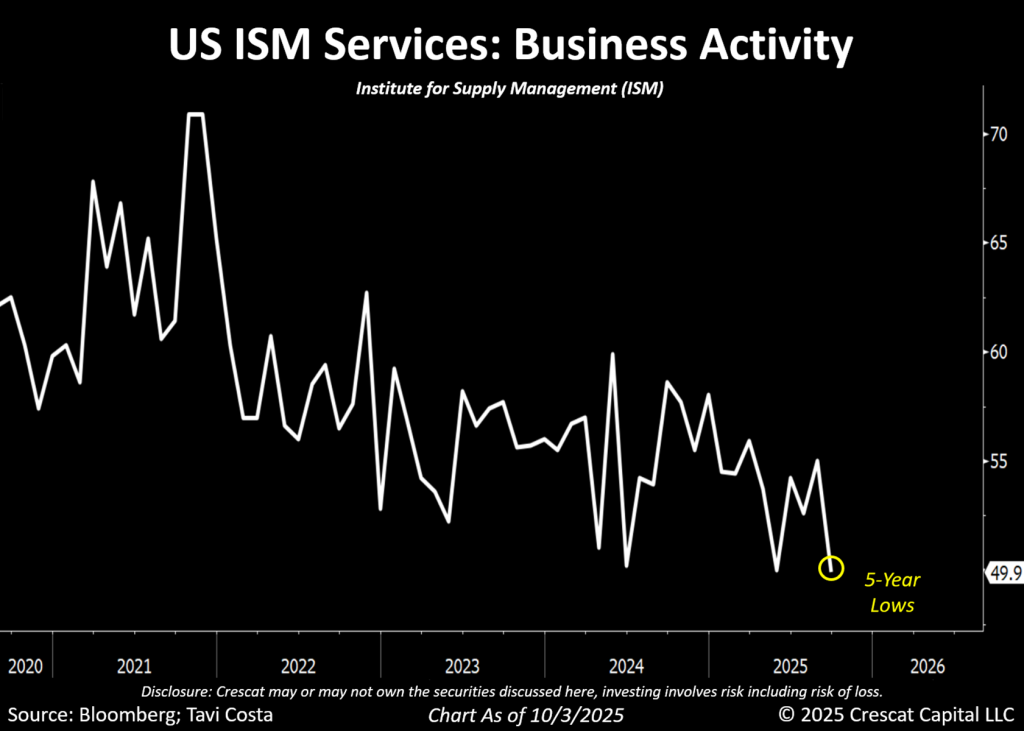 The Coming Dollar Downtrend: A New Global Order
The Coming Dollar Downtrend: A New Global Order
While traditional macro indicators remain essential for understanding the current market environment, we believe an equally critical — and often underappreciated — dimension lies in the trajectory of the US dollar. It remains the single variable that continues to anchor global financial dynamics and, in many ways, still defines the rhythm of capital flows worldwide.
Conventional wisdom tends to view a strengthening dollar as a sign that investors are seeking liquidity in moments of stress. That narrative has some truth to it, but history shows a far more structural relationship at play. Over the long run, dollar cycles have consistently mirrored the relative performance of US assets compared to the rest of the world. When the dollar rises, US assets dominate; when it falls, global and emerging market assets tend to outperform.
So far this year, the US dollar has posted its weakest annual performance since the 1970s. Many see this as a temporary or technical anomaly — a short-term reaction rather than the beginning of something larger. We disagree. The evidence, in our view, points to the early stages of a secular decline in the dollar, one that could reshape global financial conditions for years to come and carry profound implications for how capital is allocated across markets.
Today, US equities trade at historically extreme valuations relative to their global counterparts, even as the country faces deepening fiscal and trade deficits. These twin imbalances are not abstract issues; they are structural problems that rarely find resolution under a strong currency regime.
If history is any guide, you don’t fix persistent deficits and overvaluation with a rising dollar. Quite the opposite. We believe a weaker dollar increasingly looks like the implicit — and perhaps inevitable — policy choice the US will need to make to stabilize its financial position and avoid a broader economic dislocation.
Seen through that lens, the potential depreciation of the dollar could act as the catalyst for a much broader reconfiguration of global capital flows. As the dollar weakens, the gravitational pull of capital begins to shift. Assets and businesses outside the United States — many of which have been neglected and remain deeply undervalued — could see a meaningful re-rating as investors search for value in new geographies.
In practical terms, this transition may well mark the start of a long-overdue redistribution of global wealth and investment opportunity. For more than a decade, dollar strength has suppressed returns abroad while inflating valuations at home. A reversal in this cycle would not just rebalance capital — it would redefine where growth, productivity, and value creation take place in the next global expansion.
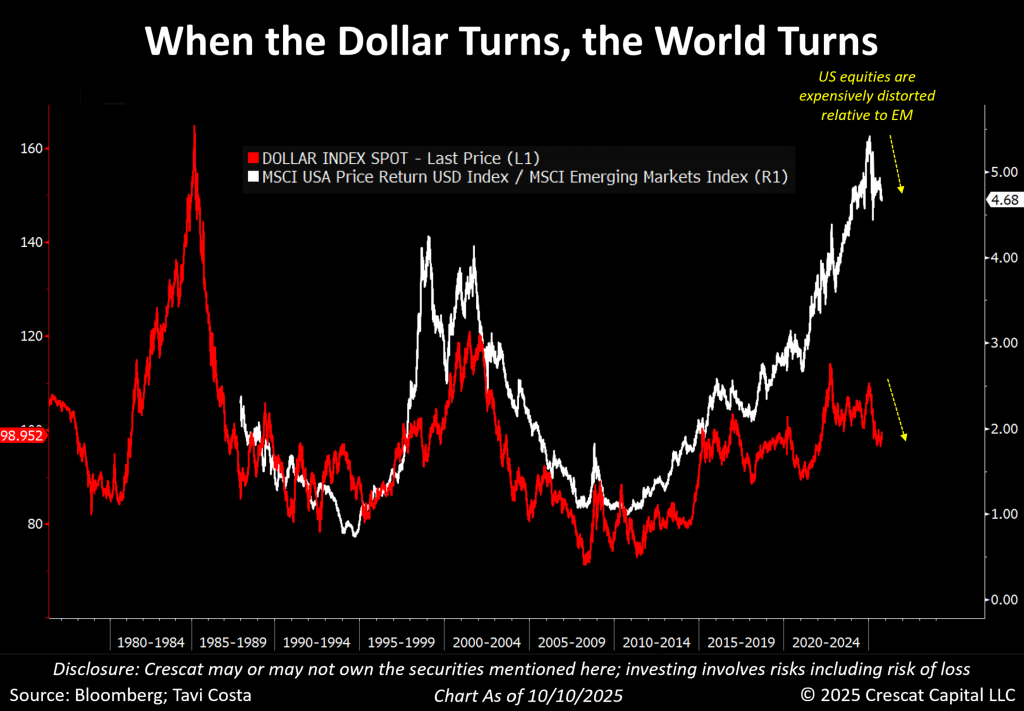 A Structural Shift in Dollar Diplomacy
A Structural Shift in Dollar Diplomacy
Bessent’s recent assertion that the Argentine peso is deeply undervalued — alongside a currency swap agreement that involved the direct purchase of pesos — represents a fundamental departure from the traditional framework of US foreign exchange engagement.
By framing the operation as an opportunity to “buy low and sell high,” Bessent effectively redefined the US Treasury’s role in FX markets — from a stabilizing authority to an active, valuation-driven participant. This language has no modern precedent. Never before has a US Treasury Secretary so explicitly characterized an FX operation as an investment, rather than a macro-stabilization measure.
Historically, American interventions in foreign exchange have been defensive, not opportunistic.
The 1995 Mexican rescue, financed through the Exchange Stabilization Fund (ESF), was structured as a loan and credit guarantee program — aimed at averting systemic contagion, not capturing currency appreciation. The 1998 Brazilian package and the 2002 Uruguayan bridge loan followed the same model: temporary liquidity backstops, conditional financing, and IMF oversight. Even the coordinated actions under the Plaza Accord of 1985 — when the US and G5 partners intervened to weaken an overvalued dollar — were designed for macro rebalancing, not speculative return.
None of these episodes involved an open-market purchase of a foreign currency undertaken for its perceived undervaluation.
This makes the Argentine operation qualitatively different. It blends the optics of a bailout with the mechanics of a directional trade. Rather than simply supplying liquidity, the US is assuming direct FX exposure — taking a risk-bearing position in the peso itself.
Such a move implies something deeper in our view: an implicit acknowledgment that the US dollar is excessively valued and that the policy establishment now views a weaker dollar as a necessary adjustment mechanism.
This shift occurs against a backdrop of fiscal dominance and financial repression — where debt servicing costs as a share of GDP exceed those of any major economy, and where policy increasingly subordinates monetary integrity to fiscal necessity. The combination of these forces, alongside a Treasury openly signaling discomfort with dollar strength, marks a turning point in global macro policy.
If sustained, this could usher in one of the most consequential reversals in the dollar cycle in decades — potentially favoring emerging markets, real assets, and non-US exposure as global capital begins to rotate away from dollar-denominated assets.
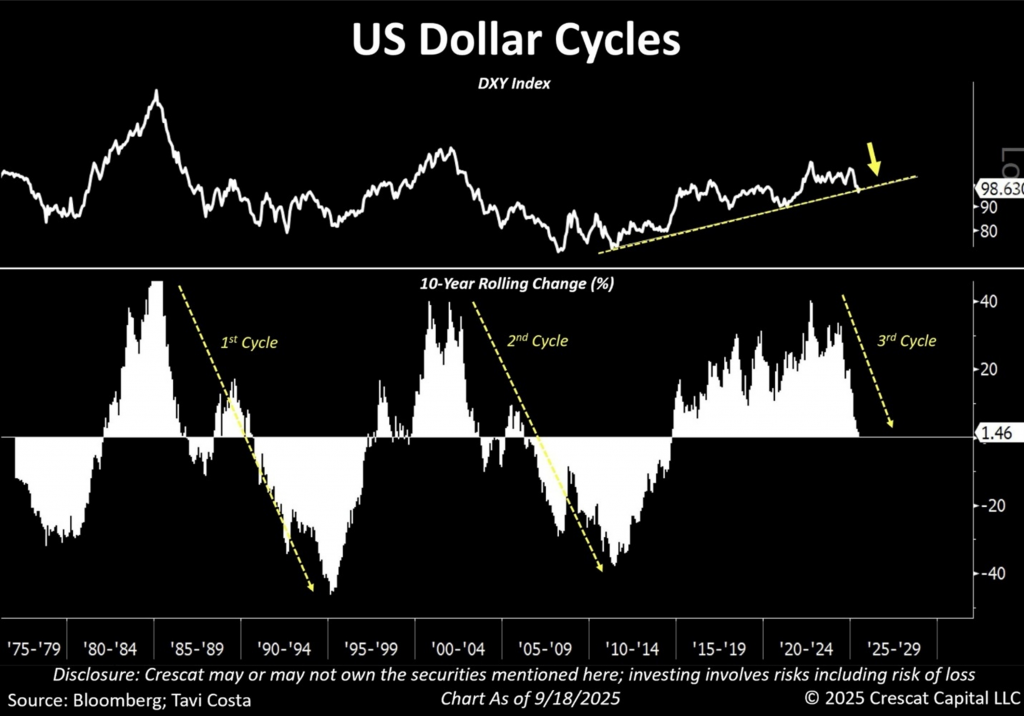
All Crescat Funds and SMA Composites vs. Benchmarks Performance
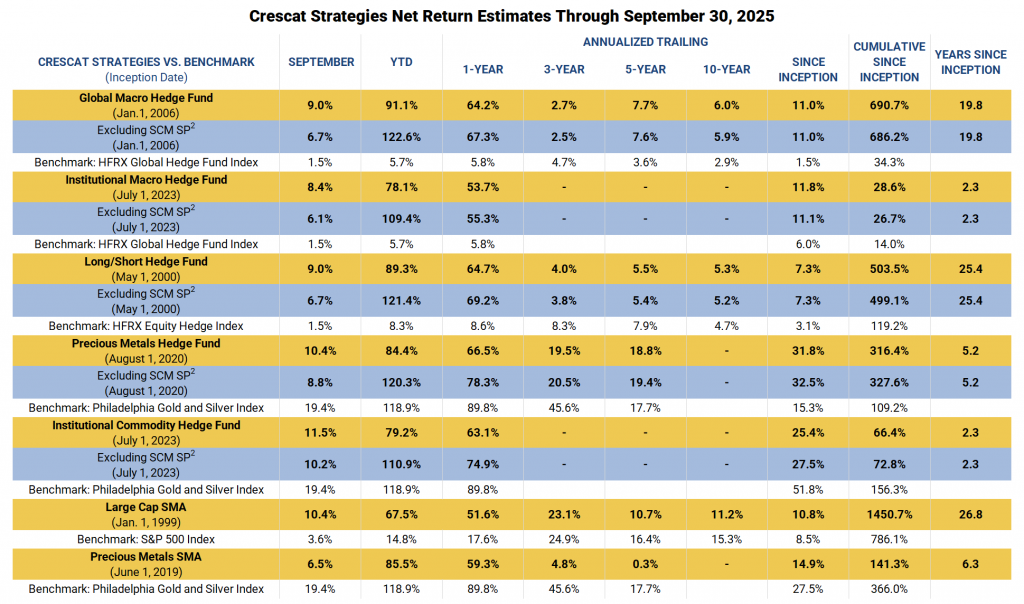 Past performance does not guarantee future results. Investing involves risk including risk of loss. See additional important disclosures below.
Past performance does not guarantee future results. Investing involves risk including risk of loss. See additional important disclosures below.
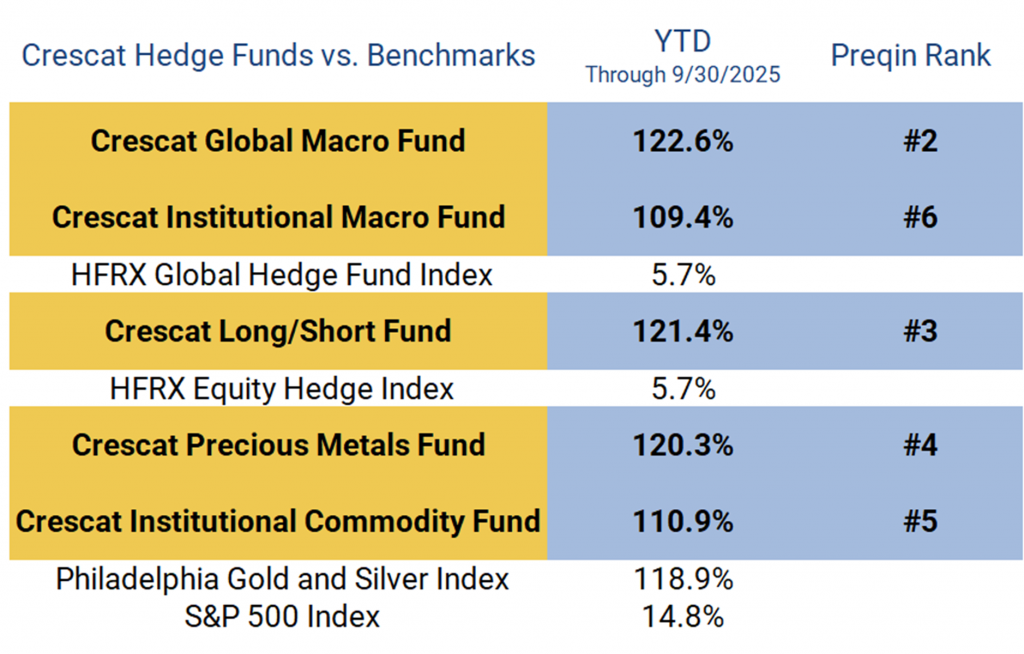
Most recent month’s performance is based on preliminary estimates. Performance data represents past performance, and past performance does not guarantee future results. Performance data is subject to revision following each monthly reconciliation and/or annual audit. Performance figures presented Excluding SCM SP represent the fund’s net returns calculated without the impact of the San Cristobal Mining, Inc. side pocket that was designated on July 1st, 2024. The side pocket includes a private equity asset that is not available to new investors in the funds on or after July 1, 2024. Excluding these assets provides a clearer view of the performance to investors coming into the funds after that date. New investors cannot participate in the SCM Side Pocket and will not share in its potential gains or losses. Investors should consider both the overall performance and the performance excluding the side pocket when evaluating the fund’s returns. Net returns reflect the performance of an investor who invested from inception and is eligible to participate in new issues and side pocket investments. Net returns reflect the reinvestment of dividends and earnings and the deduction of all expenses and fees (including the highest management fee and incentive allocation charged, where applicable). An actual client’s results may vary due to the timing of capital transactions, high watermarks, and performance. Data shown is generated by Preqin, a leading provider of data and intelligence for the alternative assets industry. Fund managers, including Crescat, report their performance information to Preqin. Crescat pays an annual fee to Preqin to have access to the database, which gives us the ability to generate this report. The rankings are versus all 483 hedge funds in the Preqin database and YTD performance updated through September 2025 as of 10/10/2025. No award or ranking should be construed as a guarantee that you will experience a certain level of results, nor should it be construed as a current or past endorsement of Crescat. Additional performance information can be found on Crescat’s website here: https://www.crescat.net/performance/
Performance figures for the SMA composites have been restated and may differ from performance previously presented in Crescat materials for these strategies. Please see important disclosures regarding this table below.
Sincerely,
Kevin C. Smith, CFA
Founding Member & Chief Investment Officer
Tavi Costa
Member & Macro Strategist
Quinton T. Hennigh, PhD
Member & Geologic and Technical Advisor
For more information, including how to invest, please contact:
Marek Iwahashi
Head of Investor Relations
miwahashi@crescat.net
(720) 323-2995
Linda Carleu Smith, CPA
Co-Founding Member & Chief Operating Officer
lsmith@crescat.net
(303) 228-7371
© 2025 Crescat Capital LLC
Important Disclosures
Discussion and details provided are for informational purposes only. This letter is not intended to be, nor should it be construed as, an offer to sell or a solicitation of an offer to buy any security, services of Crescat, or its Funds. The information provided in this letter is not intended as investment advice or recommendation to buy or sell any type of investment, or as an opinion on, or a suggestion of, the merits of any particular investment strategy. This letter may contain certain forward-looking statements, opinions and projections that are based on the assumptions and judgments of Crescat with respect to, among other things, future economic, competitive and market conditions and future business decisions, all of which are difficult or impossible to predict accurately and many of which are beyond the control of Crescat. Because of the significant uncertainties inherent in these assumptions and judgments, you should not place undue reliance on these forward looking statements, nor should you regard the inclusion of these statements as a representation by Crescat that these objectives will be achieved.
CPM has not sought or obtained consent from any third party to use any statements or information indicated herein that have been obtained or derived from statements made or published by such third parties.
All content posted on CPM’s letters including graphics, logos, articles, and other materials, is the property of CPM or others and is protected by copyright and other laws.
Performance
Performance data represents past performance, and past performance does not guarantee future results. Performance data, including Estimated Performance, is subject to revision following each monthly reconciliation and/or annual audit. Individual performance may be lower or higher than the performance data presented. The currency used to express performance is U.S. dollars. Before January 1, 2003, the results reflect accounts managed at a predecessor firm. Crescat was not responsible for the management of the assets during the period reflected in those predecessor performance results. We have determined the management of these accounts was sufficiently similar and provides relevant performance information.
1 – Net returns reflect the performance of an investor who invested from inception and is eligible to participate in new issues and side pocket investments. Net returns reflect the reinvestment of dividends and earnings and the deduction of all expenses and fees (including the highest management fee and incentive allocation charged, where applicable). An actual client’s results may vary due to the timing of capital transactions, high watermarks, and performance.
2 – Performance figures presented, excluding SCM SP, represent the fund’s net returns calculated without the impact of the San Cristobal Mining, Inc. side pocket that was designated on July 1st, 2024. The side pocket includes a private equity asset that is not available to new investors in the funds on or after July 1, 2024. Excluding these assets provides a clearer view of the performance to investors coming into the funds after that date. New investors cannot participate in the SCM Side Pocket and will not share in its potential gains or losses. Investors should consider both the overall performance and the performance excluding the side pocket when evaluating the fund’s returns.
3 – The SMA composites include all accounts that are managed according to CPM’s precious metals or large cap SMA strategy over which it has full discretion. Investment results shown are for taxable and tax-exempt accounts. Any possible tax liabilities incurred by the taxable accounts are not reflected in net performance. Performance results are time weighted and reflect the deduction of advisory fees, brokerage commissions, and other expenses that a client would have paid, and includes the reinvestment of dividends and other earnings.
Benchmarks
PHILADELPHIA STOCK EXCHANGE GOLD AND SILVER INDEX. The PHLX Gold/Silver Sector Index (XAU) is a capitalization-weighted index composed of companies involved in the gold or silver mining industry. The Index began on January 19, 1979.
S&P 500 INDEX. The S&P 500® is widely regarded as the best single gauge of large-cap U.S. equities. The index includes 500 leading companies and covers approximately 80% of available market capitalization.
S&P Select Industry Indices are designed to measure the performance of narrow GICS® sub-industries. The Metals and Mining Select Industry Index comprises stocks in the S&P Total Market Index that are classified in the GICS Aluminum, Coal & Consumable Fuels, Copper, Diversified Metals & Mining, Gold, Precious Metals & Mining, Silver and Steel sub-industries.
References to indices, benchmarks or other measures of relative market performance over a specified period of time are provided for your information only. Reference to an index does not imply that the fund or separately managed account will achieve returns, volatility or other results similar to that index. The composition of an index may not reflect the manner in which a portfolio is constructed in relation to expected or achieved returns, portfolio guidelines, restrictions, sectors, correlations, concentrations, volatility or tracking.
Hedge Fund disclosures: Only accredited investors and qualified clients will be admitted as limited partners to a CPM hedge fund. For natural persons, investors must meet SEC requirements including minimum annual income or net worth thresholds. CPM’s hedge funds are being offered in reliance on an exemption from the registration requirements of the Securities Act of 1933 and are not required to comply with specific disclosure requirements that apply to registration under the Securities Act. The SEC has not passed upon the merits of or given its approval to CPM’s hedge funds, the terms of the offering, or the accuracy or completeness of any offering materials. A registration statement has not been filed for any CPM hedge fund with the SEC. Limited partner interests in the CPM hedge funds are subject to legal restrictions on transfer and resale. Investors should not assume they will be able to resell their securities. Investing in securities involves risk. Investors should be able to bear the loss of their investment. Investments in CPM’s hedge funds are not subject to the protections of the Investment Company Act of 1940.
Those who are considering an investment in the Funds should carefully review the relevant Fund’s offering memorandum and the information concerning CPM. For additional disclosures including important risk disclosures and Crescat’s ADV please see our website: https://www.crescat.net/due-diligence/disclosures/